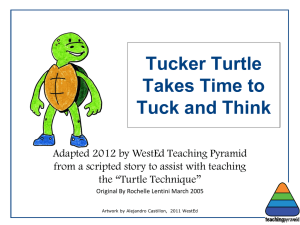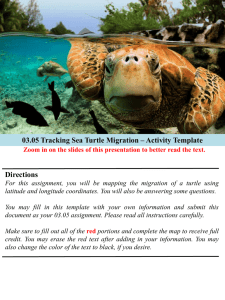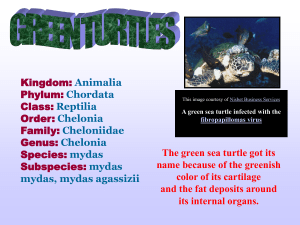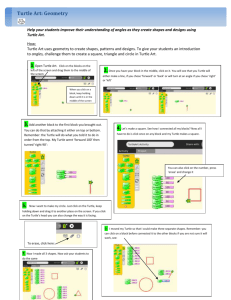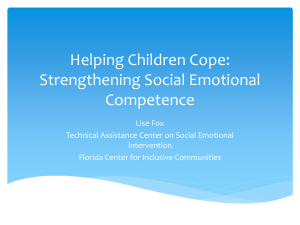Mod 2.4 - Alternatives to Anger and Impulse - Script 1
advertisement
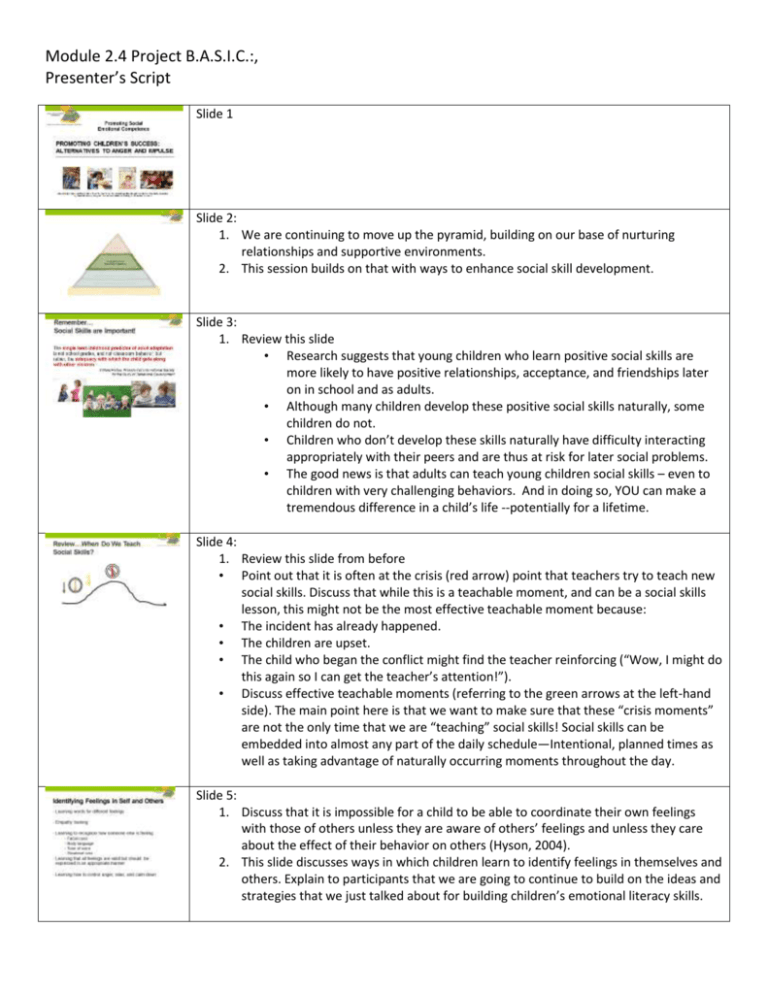
Module 2.4 Project B.A.S.I.C.:, Presenter’s Script Slide 1 Slide 2: 1. We are continuing to move up the pyramid, building on our base of nurturing relationships and supportive environments. 2. This session builds on that with ways to enhance social skill development. Slide 3: 1. Review this slide • Research suggests that young children who learn positive social skills are more likely to have positive relationships, acceptance, and friendships later on in school and as adults. • Although many children develop these positive social skills naturally, some children do not. • Children who don’t develop these skills naturally have difficulty interacting appropriately with their peers and are thus at risk for later social problems. • The good news is that adults can teach young children social skills – even to children with very challenging behaviors. And in doing so, YOU can make a tremendous difference in a child’s life --potentially for a lifetime. Slide 4: 1. Review this slide from before • Point out that it is often at the crisis (red arrow) point that teachers try to teach new social skills. Discuss that while this is a teachable moment, and can be a social skills lesson, this might not be the most effective teachable moment because: • The incident has already happened. • The children are upset. • The child who began the conflict might find the teacher reinforcing (“Wow, I might do this again so I can get the teacher’s attention!”). • Discuss effective teachable moments (referring to the green arrows at the left-hand side). The main point here is that we want to make sure that these “crisis moments” are not the only time that we are “teaching” social skills! Social skills can be embedded into almost any part of the daily schedule—Intentional, planned times as well as taking advantage of naturally occurring moments throughout the day. Slide 5: 1. Discuss that it is impossible for a child to be able to coordinate their own feelings with those of others unless they are aware of othersʼ feelings and unless they care about the effect of their behavior on others (Hyson, 2004). 2. This slide discusses ways in which children learn to identify feelings in themselves and others. Explain to participants that we are going to continue to build on the ideas and strategies that we just talked about for building childrenʼs emotional literacy skills. Slide 6: 1. Describe how anger can interfere with thinking. Children need to learn how to recognize anger in themselves and others and understand appropriate ways to express anger. We just talked about several ways for children to learn to recognize anger (list ideas from above). We are now going to talk about some ways to teach children how to handle anger. It is important to teach young children effective ways to control their anger and impulse in conflict situations because: a) Aggression and inadequate impulse control are perhaps the most potent obstacles to effective problem solving and successful relationships in childhood. b) Aggressive children are more likely to experience peer rejection and continued social problems for years afterwards. c) Evidence also suggests that aggressive children are more likely to misinterpret another peer’s or person’s intentions as hostile or threatening. Slide 7: 1. Present two feeling words that we don’t typically teach young children but that are very powerful. Those are “tense” or “stressed” and “calm” or “relaxed.” • Explain that young children are often told to “calm down” but are not aware of what this means. 2. Lead a discussion with participants about explaining the concept of “calm” to young children. The following slides show some examples of teaching strategies for explaining the concept of calm. Slide 8: 1. Other ways to teach calm and tense are: • Tense like a tin man and calm like a Scarecrow (Webster-Stratton, 1990). • Tense like uncooked pasta, relaxed like cooked pasta (can demonstrate with pasta). 2. It is also important to describe how you get children from tense to relaxed. • One way is by taking three deep breaths. Emphasize that these need to be very deep belly breaths (like you are blowing out birthday cake candles). • Children can also take deep, slow breaths with the mantra “Inhale Green; Exhale Red” - combine the mantra with the visualization of brining in calm, good, “green” thoughts and feelings while sending out angry, stressed, “red” thoughts • Children can practice the Resting Slide 9: 1. Describe the relaxation thermometer activity for children (Webster-Stratton, 1990). 2. The relaxation thermometer is used to teach children to calm down using the following steps: • Children can decorate their relaxation thermometer with pictures of feeling faces from “happy” and “relaxed” in the blue (or cool) section of the thermometer—all the way up to “angry” or “stressed out” in the red (or hot) section of the thermometer. • The adult can then ask children to describe a recent conflict and together with the child retrace the steps that led to the angry outburst. The adult writes down the child’s actions, thoughts, and words that indicated an escalating anger pattern (e.g., thinking “He always takes my toys,” yelling, kicking). • • Then the adult discusses with the child the thoughts, words, and actions that the child can use to reduce his or her anger. As adults retrace the steps of the angry outburst, they help the children identify the place where they were aware they were getting angry. This place is marked as the “Danger Point” on the thermometer. Once children have established their danger points, they give it their own name (e.g., chill out, cool down, code red, hot engine, etc.). This code word can be the adult and child’s signal that anger or stress has reached the threshold, which triggers the use of an agreed upon calming strategy, such as taking three deep breaths. Slide 10: 1. We’ve discussed how children may feel and act when they are angry. 2. The turtle technique was originally developed to teach adults anger management skills and later was successfully adapted for school-age children (Schneider, 1974). 3. Describe the basic steps of the turtle technique. • Recognizing that you feel angry. • Thinking “stop.” • Going into your “shell,” taking three deep breaths, and thinking calming, coping thoughts: “It was an accident. I can calm down and think of good solutions. I am a good problem solver.” • Coming out of your “shell” when calm and thinking of some solutions to the problem. 4. In essence, the turtle technique seeks to help children learn to replace aggressive acts with a more effective and efficient behavioral alternative. 5. Teaching the turtle technique to children can happen at large and small group times. A turtle puppet is helpful and keeps children engaged during the lesson. • The teacher can begin by introducing the turtle to the class. After the children get a chance to say hello and perhaps give a gentle pet, the teacher shares the turtle’s special trick for calming down. • The turtle describes a time he got upset in school (selecting an incident familiar to the children is best). He demonstrates how he thinks to himself, “STOP,” then goes into his shell and takes three deep breaths; After he takes three deep breaths, he thinks to himself, “I can calm down and think of some solutions to solve my problem.” At this point in the process, the turtle technique is used to demonstrate that when he is calm, he comes out of his shell and is ready to problem solve peacefully. To create a sufficient level of practice, the teacher can then invite the children to practice the turtle’s secret. For example, children can practice “going in their shells” as they go under a large sheet and take three deep breaths or an individual child can model the “turtle technique” in front of the class. Slide 11: 1. This shows an example of a social story, Tucker the Turtle Takes Time to Tuck and Think, that can be used to teach the turtle technique. 2. This story can also be placed in the reading area of the classroom so children can practice the technique! 3. Tell participants that this social story can be downloaded from the CSEFEL web site if they do not have a copy in their classroom. Slide 12: Read Story Slide 13: Slide 14: Slide 15: Slide 16: Slide 17: Slide 18: Slide 19: Slide 20: Slide 21: 1. This shows an example of a social story, When Tucker the Turtle Gets Too Excited He Takes Time to Tuck and Think, that can be used to teach the turtle technique for controlling impulses 2. This story can also be placed in the reading area of the classroom so children can practice the technique! 3. Tell participants that this social story can be downloaded from the Team TN web site if they do not have a copy in their classroom. Slide 22: Slide 23: 1. Families can be involved in the Turtle Technique. 2. Turtle notes can be sent home to inform parents about children’s growth in managing his or her anger. • This also provides additional positive feedback at home. Slide 24: Slide 25: 1. This is a “resting” pose in yoga – called the “Child’s Pose” 2. Children can kneel on hands and knees and roll backwards into this pose, tucking their heads into their shells like Tucker. • While tucked into their “shells,” have children take 3 deep breaths. • The nature of this pose stretches out the back muscles and releases stress. 3. When they are calm, children can sit up and begin problem solving steps. Slide 26: When we talk about feelings, we often tell children that it’s okay to feel angry, but it is not okay to express that feeling by hitting or kicking our friends. These “Get the Mad Out” activities provide children with safer options for expressing their anger or frustration. Slide 27: Indirect teaching, as we discussed related to emotional literacy, can be used to support impulse control. Stop & Go (Redlight, Greenlight) and Fast & Slow are direction games that teach children how to control their bodies and impulses. Slide 28: Lead a discussion with participants about the ways that children express and experience anger. Slide 29: • • • • • Encourage the participants to partner up and create a lesson plan focused on anger management. Come back to the larger group and share the lesson plans that teachers created. ADDITIONAL RESOURCES Activity NooksTucker Way to go! Notes Tucker Turtle Puzzles Tucker Turtle Color by Numbers Tucker Turtle Coloring Pages Tucker Turtle Dot-to-Dot Tucker Turtle Crossword Puzzle Tucker Turtle Puppets A Collection of Anger Management Impulse Control Lessons & Activities Helping Young Children Control Anger and Handle Disappointment - Article Super Turtle Costume Tucker Turtle Song Get the Mad Out Cookies Brief 19 - Helping Children Express Their Wants and Needs Slide 30:




